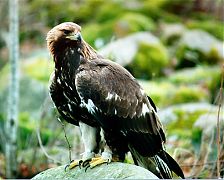Golden Eagle
 The golden eagle is a large bird of prey, powerful and clever, with a wing span of up to 227 cm and a body mass of 3-3.5 kg in case of male birds and 4.5-5.5 kg in case of female birds. The brow of an adult bird is dark brown, the rest of the crown and the nape are golden brown, while the beak is black and the cere yellow. The upper half of the bird’s body is dark brown with light (worn) feather edges and the entire lower half looks rather dark outdoors. A young bird is dark chocolate brown, has a golden crown, white spots on its wings and a wide white area on its tail stock.
The golden eagle is a large bird of prey, powerful and clever, with a wing span of up to 227 cm and a body mass of 3-3.5 kg in case of male birds and 4.5-5.5 kg in case of female birds. The brow of an adult bird is dark brown, the rest of the crown and the nape are golden brown, while the beak is black and the cere yellow. The upper half of the bird’s body is dark brown with light (worn) feather edges and the entire lower half looks rather dark outdoors. A young bird is dark chocolate brown, has a golden crown, white spots on its wings and a wide white area on its tail stock.
Feeding habits
In Estonia, the golden eagle feeds mainly on white hare, black grouse and great grouse. The diet is diversified by mammals like grey hare, roe, squirrel, marten and racoon dog, and birds like raven, hazelhen, mallard and crane. In winter, the golden eagle often feeds on carrion.
Nesting
The golden eagle is sedentary and spends the winter near its nesting place. Young birds who are not yet sexually mature, travel about more.
The golden eagle inhabits suitable nesting places for decades – at least a quarter of the current nesting places can be traced back through literary references to information passed on by word of mouth to the 19th century.
Golden eagles have usually chosen the pine as their nest tree. Only on rare occasions have nests been built in firs or aspens. At times, one pair of eagles has two nests that are inhabited in turn. A clutch consisting of one or two eggs is laid in the nest during the first half of March. The chicks hatch during the second half of April, and on most occasions, only one of the offspring learns to fly by the beginning of July.
Distribution and numbers
The golden eagle is common throughout Estonia. It inhabits larger natural massifs and prefers to live in bogs. At the beginning of the 20th century, 20-30 pairs of golden eagles nested in Estonia. In the years 1964-1973, the eagles were only observed in up to 12 nesting locations and nesting was successful in just 4-6 nests every years. During the last couple of decades the situation has improved and the number of golden eagles nesting in Estonia has remained rather stable at 40-50 pairs. A few nests have also been found in untraditional locations, such as on the edge of peat deposits or on lakeshores.
Reproductive parameters
The results of the Golden Eagle broods in 2004, 2005 and 2006 are as follows:
| 2004 | 2005 | 2006 | |
|---|---|---|---|
| Number of occupied nests with known breeding results | 34 | 28 | 25 |
| Number of successful nests | 6 | 13 | 13 |
| Total number of fledglings | 6 | 13 | 14 |
| Mean number of fledglings per occupied nest | 0,20 | 0,50 | 0,56 |


